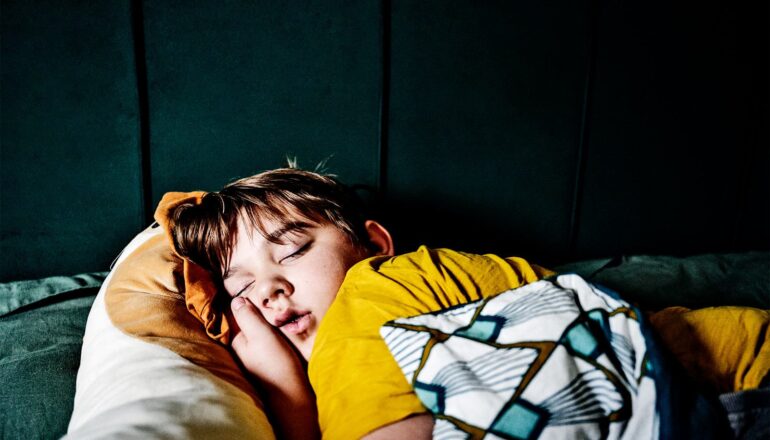Your kids may not get as much sleep as you think
- Parents often overestimate how much sleep their kids are getting, while actual sleep data shows that only 14% of children meet national sleep guidelines.
- A new study found that elementary school children get an average of only 8 hours and 20 minutes of actual sleep per night, despite parents reporting they slept more than 9.5 hours.
- Racial disparities in sleep were also observed, with Latino children averaging just over 8 hours of sleep per night compared to 8.5 hours for non-Latino children.
- Parents’ perceptions of their child’s sleep patterns often don’t match the actual data, and some cultural factors like later bedtimes and co-sleeping may influence both sleep behavior and parental perceptions.
- The researchers recommend that families take proactive steps to support healthy sleep habits, such as establishing bedtime routines, maintaining consistent schedules, encouraging physical activity, and limiting screens before bedtime.

While many parents assume that putting a child to bed means they will quickly be asleep, a new study found that’s often not the case.
The study in Frontiers in Pediatrics tracked the sleep patterns of 102 elementary school children, over the course of a week. While 83% of parents believed their child was sleeping the right amount, sleep trackers showed that only 14% of the children met national sleep guidelines.
The findings add to growing concerns that American children aren’t getting the sleep they need.
“What parents often don’t see is how long it takes for kids to fall asleep or how often they wake up during the night,” says Diana S. Grigsby-Toussaint, the study’s senior author and an associate professor at the Brown University School of Public Health.
To better understand what happens after the lights turn off, the researchers used wrist-worn accelerometers to track children’s bedtimes, how long it took them to fall asleep, how often they woke up, and how much time they spent sleeping. Parents filled out surveys and daily sleep diaries. The goal was to see how well parents’ perceptions matched up with their children’s realities, Grigsby-Toussaint says.
According to the American Academy of Pediatrics, children between ages 6 and 12 should get between nine and 12 hours of sleep per night. Data from the accelerometers showed that on average, the children were getting only eight hours and 20 minutes of actual sleep. Parents, however, reported their kids slept more than nine and a half hours.
Digging into data, the researchers found that the gap was due to time parents didn’t account for. Children were awake for an average of more than 38 minutes per night, while parents reported under five minutes of nighttime wakefulness for their children.
To better understand racial and ethnic disparities in sleep, which Grigsby-Touissant says are rarely factored into sleep studies, the researchers looked at differences between Latino and non-Latino children—56% of enrolled study participants were Latino. They found that Latino children averaged just over eight hours of sleep per night while non-Latino children averaged eight and a half. Only 4.4% of Latino children in the study met national sleep guidelines compared to 22.8% of non-Latino children.
The study also explored whether parents were aware of problems related to sleep. Latino caregivers, for instance, were more likely than other groups to report that sleep was a concern, and to say their child had trouble staying asleep. Meanwhile, non-Latino parents tended to underreport sleep problems.
Parents in both groups tended to overestimate how much sleep their kids were getting.
The team says that some of the findings could be explained by cultural factors, such as later bedtimes, co-sleeping, and room sharing, which are more common in Latino households. These factors might influence both sleep behavior and parental perceptions. They hope future research can explore how home environments and parenting styles affect children’s sleep patterns.
“Our work indicates that we need to improve our communication about sleep with families to capture the multiple dimensions of it,” Grigsby-Toussaint says.
The research team, which included scientists from Brown’s Warren Alpert Medical School and Brown University Health’s Rhode Island Hospital, also note the limitations of wrist devices, which don’t always distinguish between periods of wakeful rest and sleep. This means that the tracking devices, too, could over-estimate children’s sleep volume.
To improve children’s sleep, the researchers encouraged families to take proactive steps, Grigsby-Toussaint says:
“This comes down to following those tried-and-true sleep tips to support healthy sleep habits and doing all the things we know helps people get their best rest: bedtime routines, maintaining consistent sleep and wake schedules—even on the weekends—encouraging physical activity and exposure to natural light and green spaces during the day, limiting screens close to bedtime, and creating a comfortable sleep environment.”
Support for this study came from the National Institutes of Health.
Source: Brown University
The post Your kids may not get as much sleep as you think appeared first on Futurity.
